History of Colombia
From Pre-Colombian Period to Modern Day
Much of the history of Colombia does not make very pleasant reading, particularly since the 1940s. The country has been dogged by civil conflict and drug trafficking for decades both of which have caused untold misery for its people.
But the country's history stretches back long before the first gram of cocaine was ever manufactured. Here we take a look at the main periods of Colombia's fascinating history...
Pre-Colombian Period
For centuries before the Spanish colonisers arrived the region later to be called Colombia was occupied by numerous indigenous tribes. Some of the communities of this Pre-Colombian period survive to this day, others have long since disappeared, but the range of cultures that have existed in this land is idicative of this colourful multi-cultural country.
Spanish Colonisation
The first European to arrive in Colombia was Alonso de Ojeda in 1499. However, Christopher Columbus (after whom Colombia is named) never actually set foot in Colombia.
Impressed by the wealth of the local tribes, in particular their gold, the Spanish continued to arrive on the Caribbean coast of Colombia and began to push inland in search of the now infamous El Dorado (a mythical place thought to contain unimaginable riches).
The centrepoint for the El Dorado myth was Laguna de Guatavita a couple of hours from Bogota which the Spanish believed was the site of El Dorado. Despite various expeditions and searches El Dorado was never found. However, the Spanish did manage to amass a significant quantity of riches through pilaging the indigenous communities.
As the Spanish continued to arrive in Colombia settlements were gradually created. Santa Marta was the first Colombian town to be created in 1525 by Rodrigo de Bastidas. Bogota was founded in 1538 by Jimenez de Quesada.
During the following couple of centuries of Spanish colonial rule blacks began to arrive, brought in by the Spanish to work as slaves, principally along the Caribbean and Pacific coasts.
Independence from the Spanish
Towards the end of the 18th Century the inhabitants became increasingly disilusioned with Spanish rule. High taxes and duties imposed by Spain caused much resentment among the people which eventually manifested itself in the first revolt against the colonial power in Socorro (Santander departemnt) in 1781.
In the early part of the 19th century more Colombian towns rebelled, but strong political differences and infighting (something that would plague Colombia for many years to come) would inhibit a collective resistance against the Spanish.
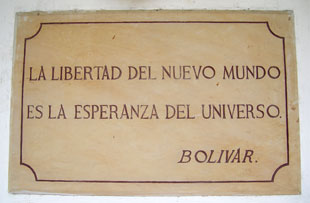
Then came Simon Bolivar.
Simon Bolivar was able to amass troops from the local population and managed to win six battles against the Spanish forces.
However, the Spanish, eager to regain control, sent reenforcements and regained control of the territory by 1817.
Bolivar regrouped and in 1819 moved into Colombia from Venezuela defeating and pushing back the Spanish across the Andes until evetually winning the decisive battle at the Puente de Boyaca on 7th August (the date on which Colombia now celebrates its Independence Day). Three days after what became known as the Battle of Boyaca Simon Bolivar arrived in Bogota to declare Colombia's independence from Spain and mark a decisive moment in the history of Colombia.
A pro-Spanish resistance continued to fight sporadically for the next few years, but by 1822 all resistance to Colombian independence had been quashed.
Simon Bolivar - a key figure in the history of Colombia
Post-Independence
Following the defeat of the Spanish the now independent territory was named Gran Colombia, which consisted of Colombia, Venezuela, Ecuador and Panama (which at that point formed prt of Colombia).
The first preseident of Gran Colombia was Simon Bolivar. Bolivar believed in a centralist republic whereas his vice-president, fellow revolutionary Francisco de Paula Santander, supported a federal system of independent states.
Bolivar had his way for less than a decade. By 1829 Venezuela had seperated from Gran Colombia and the following year Ecuador followed.
The centralist vs federal rangles which began with Bolivar and Santander would continue to rage on and play a prominent role in the history of Colombia.
In 1849 the two sides each created a political party; the Conservatives (of the centralist ideology) and the Liberals (with federal tendancies).
The following decades would be dominated by violent conflicts between the two sides. Anti-government insurrections and civil wars were frequent, the most violent of which was known as the War of a Thousand Days that began in 1899 and saw some 100,000 people killed.
In 1903 with Colombia embroilled in internal conflict the USA was able to successfully seperate Panama from Colombian control. In doing this the USA could then construct the strategically and economically important Panama Canal. It took until 1921 for Colombia to settle the dispute with the USA.
The following years would see a period of relative peace and prosperity, but that would end in 1948 as the assassination of a man on a street in Bogota would usher in a dark period in the history of Colombia.
La Violencia
On 9th April 1948 Liberal presidential candidate Jorge Eliecer Gaitan was shot dead by an assailant after leaving his club in Bogota. Gaitan was highly regarded by the Liberals of Colombia and it is generally accepted that had he not been murdered he would have been elected the next president of Colombia.
Gaitan's murderer, Juan Roa Sierra, was immediately attacked and killed and his true motivation left to speculation. Liberal suspicions lay squarely with Conservatives and as news of Gaitan's death spread like wildfire riots erupted all over the Colombian capital in what became known as El Bogotazo.
The violence between the two sides continued for the next five years beginning the period in the history of Colombia known as "La Violencia".
In 1953 General Gustavo Rojas headed a political cuup d'etat which was supported by both conservatives and liberals. He ruled for 4 years during which time he managed to secure the vote for women and also improved Colombia's infrastructure including the Atlantic Railway Project.
Despite these achievements, people became dissatisfied with his presidency and he was eventually removed from office under pressure from mass protests and strikes and replaced by a military junta of five generals.
This new government would last little more than a year.
Conservatives and Liberals, concerned that the military junta would turn into a full blown dictatorship, agreed to an accord called the National Front which allowed the two parties to take turns governing the country for four years at a time. This period in the history of Colombia would last 16 years.
Emergence of Guerrilla Groups
The National Front agreement officially ended La Violencia, but widespread dissatisfaction with the governance of the country remained, and with no alternatives to the Conservative and Liberal parties people turned to more extreme methods of bringing about their desired change.
It was during this period that the guerilla groups ELN (Ejército de Liberación Nacional), M19 (Movimiento 19 de Abril) and largest and most notorious of all FARC (Fuerzas Armadas Revolucionarias de Colombia), or 'Revolutionary Armed Forces of Colombia' in English, appeared on the scene.
The FARC - The largest guerrilla group in the history of Colombia
These armed groups, which form an important part of the history of Colombia, recruited thousands of Colombians to join their fight to overthrow what they saw as an imperialist government of the rich and replace it with their own marxist government.
In the late 1970s as FARC and other guerrilla groups continued their insurgency against the Colombian government another powerful force began to emerge.
Cocaine and The Drug Cartels
As demand for cocaine in the west grew during the late 1970s illegal groups began to form to control the production and export of the drug.
The most famous of these cartels was the Medellin Cartel, headed by drug baron Pablo Escobar, and the Cali Cartel, controlled by the Orejuela Brothers.
At the height of Pablo Escobar's power he had amassed a staggering $25 billion.
Escobar was finally killed on 2 December 1993 following a massive US-assisted man hunt.
With Escobar dead, the Medellin Cartel was effectively over. A couple of years later the Orejuela brothers were captured by the Colombian Police spelling the end for the Cali Cartel.
With the country's two most powerful drug cartels gone numerous smaller groups have moved in to fill in the vacuum.
At the end of the 1990s the US government launched Plan Colombia, designed to curb the production and trafficking of drugs (principally cocaine).
Alvaro Uribe
In 1998 Andres Pastrana was elected President of Colombia. His four year term in office is generally regarded as a huge failure.
Pastrana decided to negotiate with Colombia's two main guerrila groups, the FARC and the ELN. As part of the negotiations he ceded an area the size of Switzerland to the guerrilla. Despite this a ceasefire was never agreed and the violence continued to escalate. As the 2002 election loomed Pastrana had well and truly lost the support of the population. The people were ready for a change.
Alvaro Uribe was elected President of Colombia on 26 May 2002 on the back of promises to tackle the guerrilla with a strong hand.
During his 8 year term Alvaro Uribe achieved tremendous results in pushing back the FARC, reducing its numbers, and increasing security in the major urban areas of the country.
Alvaro Uribe was Colombian Preseident from 2002 to 2010
However, Alvaro Uribe was certainly not without his critics. Various allegations of links to right-wing paramilitary groups dogged his time in office. Many also criticised his obsession with security and his lack of policies targeting the country's social problems.
Uribe was succeeded in 2010 by Juan Manuel Santos of the same party, but he remains one of the more popular presidents in the recent history of Colombia.
Return from History of Colombia to Homepage
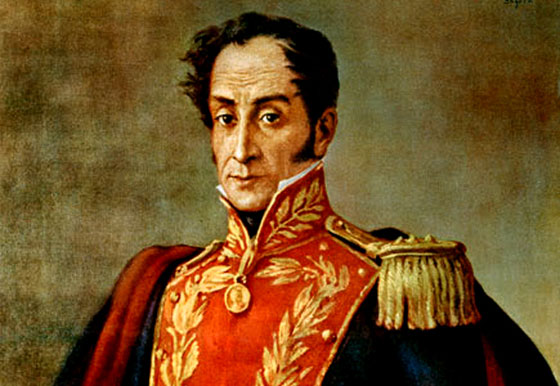
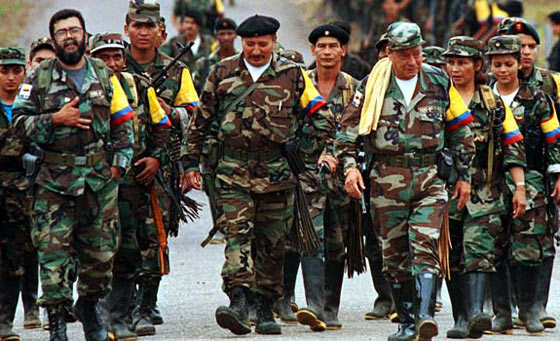
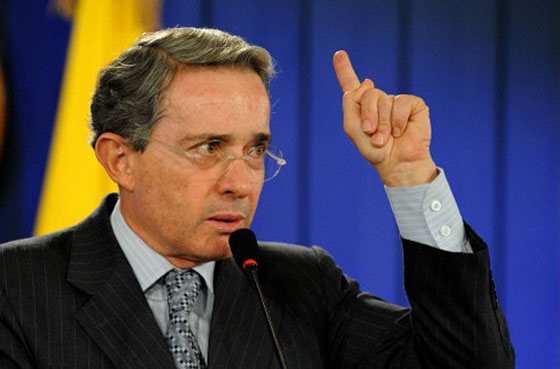
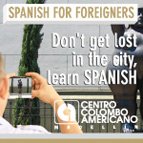







New! Comments
Have your say on the site! Leave me a comment in the box below.